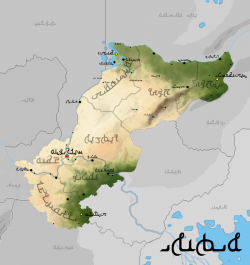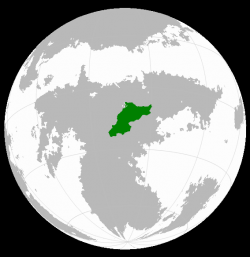Difference between revisions of "Archive:Tabiqa"
| Line 48: | Line 48: | ||
|leader_name1 = [[King Okmaruud Henuut|Tolyar Okmārūd bal Henÿt]] | |leader_name1 = [[King Okmaruud Henuut|Tolyar Okmārūd bal Henÿt]] | ||
|leader_title2 = Prime Minister | |leader_title2 = Prime Minister | ||
|leader_name2 = [[Keyvat Nahdein bol | |leader_name2 = [[Nahdein Accekoon|Keyvat Nahdein bol Aċegoon]] | ||
|legislature = <!--Name of the country/territory's governing body, e.g. "Parliament", "Congress", etc--> | |legislature = <!--Name of the country/territory's governing body, e.g. "Parliament", "Congress", etc--> | ||
|upper_house = <!--Name of governing body's upper house, if given (e.g. "Senate")--> | |upper_house = <!--Name of governing body's upper house, if given (e.g. "Senate")--> | ||
Revision as of 22:55, 8 January 2018
| Grand Realm of Tabiqa Duqiṫūria Tabiqa |
||||
|---|---|---|---|---|
|
||||
| Capital and | Mehyaran | |||
| Official languages | Adzamasi | |||
| Recognised regional languages | Dzimraic, Kavahiri, Osuri | |||
| Ethnic groups | 46.1% Adzamasiin 18.26% Osureko |
|||
| Demonym | Tabiqan Tabiqiri (pl) |
|||
| Government | ||||
| - | King | Tolyar Okmārūd bal Henÿt | ||
| - | Prime Minister | Keyvat Nahdein bol Aċegoon | ||
| Establishment | ||||
| - | Confederation | 17?? | ||
| Area | ||||
| - | 2,011,576 km2 776,674 sq mi |
|||
| Population | ||||
| - | 2015 estimate | 36,280,000 | ||
| - | 2011 census | 34,682,905 | ||
| - | Density | 13/km2 33.7/sq mi |
||
| GDP (nominal) | 2016 estimate | |||
| - | Total | 1,215,156,592,300 | ||
| - | Per capita | 46,235 | ||
| Gini | 71 very high |
|||
| HDI | .71 high |
|||
| Currency | Tabiqan Mahri, Ekuo (TBM) | |||
| Drives on the | right | |||
| ISO 3166 code | TBQ | |||
| Internet TLD | .tab | |||
Tabiqa (IPA: /tæbɪkə/, Adzamasi: Tabiqa, IPA: /tabɪqa/), officially the Grand Realm of Tabiqa and sometimes called the Republic of Tabiqa, is a landlocked country located in central north Baredina. A mostly desert nation, its population is concentrated in the cooler and better-irrigated areas around its mountains and rivers, and many of its inhabitants are nomadic. It is bordered by Barradiwa, Ebo Nganagam, Algador, the Povan Union, ((emptyplaceland)), and Istan.
Etymology
Tabiqa takes its name from the Tabiq river that demarcates most of its western border. The name was taken for its perceived neutrality in a country of many different regions and ethnic and cultural groups. The etymology of the river's name is unknown, possibly originating from pre-Adzamic peoples in the region.
History
See also: Adzamasi Empire, Pre-Adzamic Tabiqa
Tabiqa was first inhabited by early hominids at least one million years ago, and by early modern humans shortly after their appearance on Sahar. Varying peoples have lived in it under different regimes and empires for millennia. Its location in the Baredina desert alongside some of the only major waterways that cross the expanse has given it great strategic trading power throughout history.
The modern nation is a successor state of the Adzamic Empire (Tahid Ādzamiyād), which collapsed in the 900s largely due to the rising Neviran Empire to the east. Modern state borders were established in the 1?00s, which overtook one another for a period of ?00 years, eventually leaving modern Tabiqa's three immediate predecessor states: the Kingdom of Mehyara, the Republic of Kasingadh, and the Kingdom of Osuria. After the annexation of the Kasingadh province by Mehyara, the two remaining kingdoms unified into the Kingdom of Tabiqa by choice.
Tabiqa became a democracy after the end of the Great Ekuosian War, but retains a mostly-symbolic monarchy.
Geography
Tabiqa is bordered by the Tabiq river in the west, the Anuxaz river to the north, and the Püzimmese mountains in the east. It is a landlocked country, but has access to the Kasingadh lakes in the northwest.
Geology
Most of Tabiqa is fairly high above sea level, with a few mountains in the east. The rest of the country is mainly situated on a broad desert marked only by sand dunes, with small valleys cradling the rivers to the north and western borders.
Climate
Tabiqa is mainly situated in the Baredina desert and, as such, is a very hot, dry, and arid country. Some parts of the country experience a short wet season, but most of it can go for an entire year without rain. There are fertile river valleys surrounding the major waterways, and some arable land near the lakes in the north-west an the eastern mountains, but most of the country is only fit for habitation by nomadic peoples.
In the northeast there is a fertile tropical savannah climate, which is responsible for most agriculture in Tabiqa. Deforestation to increase space for farmland has lead to desertification, first noticed in the 1920s, and replanting efforts since 1960 have begun to slow this process.
In the far south is a small swathe of tropical monsoon climate.
Biodiversity
Politics
Government
Tabiqa's head of state is a monarch (the tolyar), who held total power until the end of the Great Ekuosian War. The monarch is now mostly a figurehead, although some powers are still vested with the throne. A president elect serves as the functional head of a government, alongside a small congress.
Administrative divisions
Foreign relations
Military
Main article: Tabiqan military
Tabiqa's military is well-funded conscript army and air force. A disproportionate amount of tax dollars go towards the military. At 20 years of age all Tabiqiri are conscripted to serve a minimum two-year term (including 2-8 months of training), with exceptions for medical, psychiatric, and some other extenuating circumstances. Those who wish not to serve for religious, moral, or ideological reasons will be given non-combatant roles. Postsecondary students, including those studying abroad, may delay their service for up to four years for a Bachelor's program, six years for a Master's, or may be exempted if they successfully progress towards a Doctorate degree. For all reasons, a mere 17% of Tabiqiri are exempted from or delay their military service.
Tabiqiri may opt to begin military service as early as 16; 43% of the population begins training before they turn 20. Some postsecondary degrees can be obtained concurrently with a four-year or longer term, which also pays students' tuition, room, and board. Approximately 13% of Tabiqiri choose this route, representing about 58% of all citizens who attain tertiary education.
Tabiqan immigrants are required to serve or to pay into the military system. Those who are fit for service have a choice; those who are unfit for service, or who choose to, either pay a much higher "military subsidy tax" or may make a lump-sum payment towards the military. This is one of the main reasons for Tabiqa's low immigrant rate.
Outside of the military, there are a number of organized militias throughout the country, mostly in rural areas near the border with Izovangia.
Economy
Tabiqa is an extremely capitalist nation with a robust economy. The military and related sectors play a large role in the economy. Manufacturing, especially of designer clothing and other luxury goods, also makes up a key sector of the economy.
Transport
Energy
Science and technology
Tourism
Demographics
Ethnic groups
There are more than eighty recognized ethnic groups among the Tabiqan population, at least sixteen of which are considered native to the region. The most populace is, by far, Adzamasi, representing over 32% of the population.
Gender
Tabiqa legally recognizes four different genders, and some parts of the population culturally recognize five or more genders as well.
Urbanisation
Language
The official language of Tabiqa is Adzamasi. Standard Adzamasi and its related dialects are spoken natively by approximately 32% of the population, and fluently by a further 22%, for a total of 54% fluency in the nation. Most other inhabitants speak at least one of the other major languages: Osuri, Kavahiri, or Chikama. Together, these languages are spoken by 96% of the country's inhabitants.
Education
Healthcare
Religion
A very large proportion of the population follows Adzamasiin religion.
Culture
Heritage
Architecture
Tabiqa is internationally renowned for its modern architecture in its larger cities such as Mehyaran, Sedhishum'a, Ziathi, and Hadebal. It is also home to several architectural wonders of the ancient world.
Fashion
Mehyaran is one of the fashion capitals of the world ((or at least it pretends that it is)).


